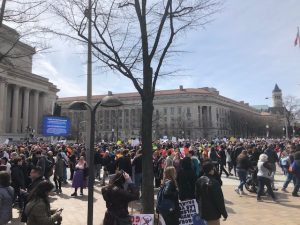By Samantha Samuel-Nakka
I attended the March for Our Lives rally in Washington D.C. with my family, including my one year old son. When we arrived at the Archives Square metro stop, the Metro Police offered to escort us (and our stroller) out of the station because of the volume of people congregating in the Square. As a Washington D.C. native, it was unlike anything I’ve ever seen before.
The March brought an estimated 800,000 people to the nation’s capital on March 24th to rally around the urgency for gun control and demand an end to gun violence. There were also over 800 “sibling” marches in cities across the globe. One of the first things I noticed when we got to the event was this palpable energy in the air. It was contagious and electrifying. There were people of all ages (from infants decorated with protest signs like my son to grandparents chanting for their grandchildren), races and ethnicity, and from many regions unifying their voices to demand more from their governments and elected officials.
The March organically created a (physically visible) collective community. People were unafraid to engage with strangers, converse with one another, exchange pictures, stories and ultimately find a common thread of solidarity toward the same cause. It was humbling to see that your own individual desire for gun control and ending gun violence was not only a shared sentiment, but was also a tangible majority view, exemplified from the crowd around you. That sense of collectivity made me feel that there is strength in numbers and maybe, with this shared unity, change is possible.
Inclusiveness
What struck me most about the March was its extraordinary inclusiveness. This inclusiveness took different forms. The first was the spectrum of speakers on the stage. The organizers successfully broadened the scope of the March from solely being focused on a single event at Parkland, Florida to highlight the devastating impact of gun violence across the country; from suburban schools like Marjory Stoneman Douglas High School to urban inner cities of South Los Angeles. Aside from this, there was diversity in the representation of the collective voice they projected.
The biggest highlight for me was witnessing eleven year old Naomi Wadler use such directed eloquence to demand that black women, who are killed at disproportionate numbers, be included in conversations about gun violence. She said she was there to acknowledge and represent all of the black girls whose stories don’t lead on the evening news or make the front pages of newspapers. I have watched her speech online dozens of times since the March and it moves me to tears. Every. Single. Time.
The Signs and the Intersection
The diversity of the speakers and their speeches was certainly matched by a diversity in the crowds. The signs were unapologetic and defiant. There were signs indicating the relationship between gun control and preventing domestic violence, National Rifle Association’s (NRA) involvement in politics, and specific signs calling for House Speaker Paul Ryan to take action. Some of the most memorable signs for me were:
“I want to read books, not eulogies”
“Arm teachers with books, not guns”
“I want to live to see graduation”
I was really impressed by how intersectional the March was, particularly in recognizing and acknowledging that gun violence disproportionately affects people of color. Several people had signs that highlighted the excessive disciplining of black students and there were also many people representing the #BlackLivesMatter movement. Despite the intersectional approach, I do feel that discussions on the gun violence from police brutality were not represented. I personally did not see the adequate inclusion of police brutality in the March agenda, which I believe could have provided another layer to the discussion.
It has been a few weeks since the March and I am still in awe of its ability to generate thoughtful conversation and wake the political consciousness of its participants, particularly the next generation of youth. Students really took the lead with the March and have quite successfully showcased the power of youth-led activism. Since the March, they have continued to advocate, encourage people to vote and organized town-halls. These young activists have proven that the March for Our Lives is not a moment, it is a movement.
Most importantly, my participation in the March gave me a renewed sense of hope when I witnessed what these young people are capable of doing. It was the first time since President Trump took office that I have felt hopeful for the future of politics and the state of this country.

